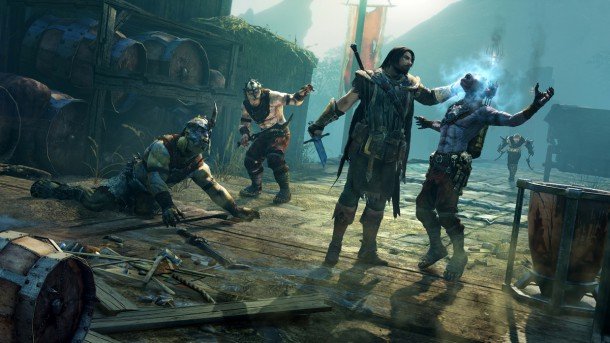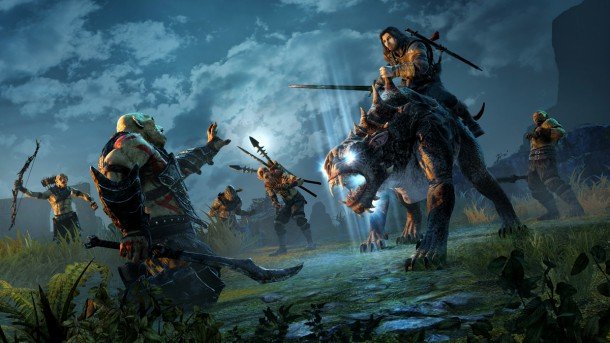Shadow of Mordor hands-on: Lord of the Rings with Batman's combat system

I had the unique experience of playing Shadow of Mordor immediately after playing Batman: Arkham Knight , which made the symmetries between the two games' combat systems even more apparent. Fighting in Shadow of Mordor feels like being Batman with a sword, sans his pesky “do not viciously impale” oath. Talion, the revenge-seeking, Aragorny lead of the game, pops seamlessly between individual orcs that encircle him, parrying enemy attacks that are telegraphed with UI, comboing off basic attacks and execution moves, flip-jumping over the heads of enemies to get behind them. It's smooth, elegant, and satisfying to be an orc-killer.
There are different tools in the toolbelt, of course (like mind control, your bow, and magic), but broadly it's a terrific idea to adapt Batman's combat system for a new franchise; it reveals the thinking that went into WB's decision to greenlight what's essentially an open-world, LOTR-branded Assassin's Creed game built in their tech. WB has taken a license that's been lying dormant in gaming as it's in the midst of a trilogy in film, pairing it with a developer whose most recent experiments ( Guardians of Middle-Earth and Gotham City Imposters ) didn't catch on.
Assassin's Creed being Ubisoft's best-selling franchise, this is arguably the safest thing WB could've done, but I think it's actually quite bold of WB to push out a licensed game that's almost entirely systems-driven. The centerpiece of Shadow of Mordor is its Nemesis system, a kind of dynamic pecking order for the randomly-generated orc warlords that populate the game's open world. These figures have their own strengths, bodyguards, and fears (like fire), and they'll rank up within the hierarchy if they kill you or challenge one of their peers and win.
I experimented with this system over about 20 minutes of gameplay—probably not an ideal amount of time—but enough to get a sense of how the Nemesis system operates in principle. Pausing the game reveals a menu that visualizes a dozen-some orcs like a field of chess pieces. Each of these orcs is a real, active character in the world—they might be a warchief, captain, or even one of Sauron's Black Captains. The goal I was given initially was to install a captain I'd mind-controlled in as a warchief. After hunting one of these orcs down in-game, and weakening them sufficiently to put them under my Wraith power, I had the option to initiate an assassination attempt on the warchief my brainwashed captain served.
This triggered a special mission inside a wood-walled fortress. Scaling the walls of the fort without detection, I made my way to an overlook to see the warboss rallying dozens of low-level orcs beside my lieutenant. My lieutenant initiated the assassination attempt on my command, injuring but not killing the warchief, a maneuver that succeeds or fails based on their comparative power rating, I'm told. From there all hell broke loose: the camp was flooded with more orcs than I could gut, and only a few deliberately-placed explosive barrels (which I could fire arrows at in slow motion by expending Wraith power) thinned the orc horde enough for me to stay alive.
Eventually the warchief is wounded enough to turn tail and run (an event that's presented by the camera swirling to the warchief's position as he delivers the equivalent of a “I'll get you next time!”) line, and the battle—if I choose to—turns into a pursuit sequence from there. I was out of arrows, which I could've used to leg the warchief and slow him down, so I had to chase him as he fled through the open world. This wasn't simple platforming; to close the gap I had to seek out tiny shortcuts and jab the sprint button whenever I fell from a decent height, a micro QTE that grants Talion a small speed boost.
Once I caught him, killing him was easy—without having to fend off his bodyguards, taking him down was relatively simple, button-mashy work. With the warchief dead, my lieutenant was promoted to take his place—something that only happened because he was lucky enough to survive the coup d'état attempt.
The biggest gaming news, reviews and hardware deals
Keep up to date with the most important stories and the best deals, as picked by the PC Gamer team.

My brief time with Shadow of Mordor was encouraging, but what's unclear, and admittedly difficult to convey in the context of a half-hour demo, is how the game's early, middle, and late game will differ, if much at all. What happens after you install four warchiefs? Do new sections of the world unlock over time? When I asked Monolith about what the game's ultimate win state is, all I got back was this cloudy comment from the game's director of design, Michael de Plater: “The Initial Goals are to discover why Talion was denied death after he was sacrificed on the Black Gate, and to discover the identity of the Wraith. The ultimate goal is something we want players to experience, but it does include realizing the full power of the Wraith.” And on progression: “We aren't revealing everything now, but there is more to come. Other weapon upgrades include unlocking Weapon Powers (special rechargeable abilities), earning experience to unlock Abilities (on separate Wraith and Ranger Trees).”
Monolith's Nemesis system is a fascinating direction for a big-budget game, but if Shadow amounts to simply seeking out camps, assassinating or mind-controlling leaders, and repeating this process ad nauseum through Mordor until your weapons are fully upgraded, I'm worried that the appeal will evaporate after a few hours. What I'm hoping for are that some truly unique, massive-scale scripted moments will be in the game alongside the enjoyable, but potentially repetitive sandboxy stuff. I'm told that the mission types will range from “story missions, side missions, power struggles, artifacts and collectibles opportunities, and hunting and survival challenges to name some,” but it's unclear whether these encounters will be fundamentally different.

Evan's a hardcore FPS enthusiast who joined PC Gamer in 2008. After an era spent publishing reviews, news, and cover features, he now oversees editorial operations for PC Gamer worldwide, including setting policy, training, and editing stories written by the wider team. His most-played FPSes are CS:GO, Team Fortress 2, Team Fortress Classic, Rainbow Six Siege, and Arma 2. His first multiplayer FPS was Quake 2, played on serial LAN in his uncle's basement, the ideal conditions for instilling a lifelong fondness for fragging. Evan also leads production of the PC Gaming Show, the annual E3 showcase event dedicated to PC gaming.

